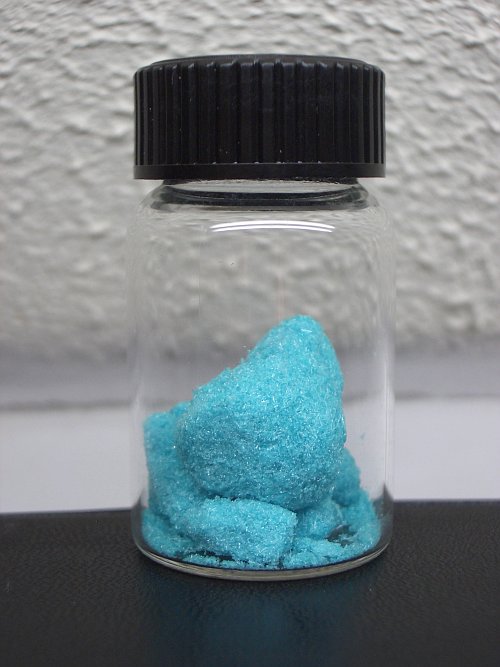
The brown material definitely is the anhydrous compound. I have made that as well. Add a little of the brown material to water. Does it dissolve to a green or blue solution? Is the solution 100% clear or somewhat turbid? If the CuCl2 anhydrous is prepared by heating, then it might be that there is a small amount of oxychloride or even oxide in the sample, due to driving off HCl. A carefully prepared sample, however, will dissolve without any turbidity.
I cannot make anything of the bright blue compound you have. I have never seen such a compound when based on copper chloride. My sample of copper chloride becomes green when a drop of water is added to it. Concentrated solutions are green (chloro complexes) and dilute solutions are blue (aqua complexes). Just a few suggestions:
1) Heat a small sample of the bright blue compound. What color do you obtain? Brown like the anhydrous CuCl2?
2) Dissolve some of the bright blue compound in water. Do you get a clear solution?
3) Add some NaOH solution (just a few drops) to your solution, prepared in (2). Do you get a bright blue precipitate, or a dirty green one? The latter is obtained if you have high concentration of chloride in solution.
If indeed the blue compound is CuCl2 as well, then I have learned something new.




 is green,
Cu(H<sub>2</sub>O)<sub>6</sub><sup>2+</sup> is blue (add NaCl or HCl to CuSO4 to see the colour change). Whether
that is the cause of the difference in colour of your crystals remains to be determined.
is green,
Cu(H<sub>2</sub>O)<sub>6</sub><sup>2+</sup> is blue (add NaCl or HCl to CuSO4 to see the colour change). Whether
that is the cause of the difference in colour of your crystals remains to be determined.
 .... I'm suspecting carbonate ions since any heating is
obviously preventing the formation of blue crystals and CO2 is indeed driven out of the solution by heating... So I was thinking of saturating conc.
CuCl2 solution with CO2, but then remembered that I could simply dissolve CuCl2 in some "fizzy water", keeping the solution cold (ice bath)
.... I'm suspecting carbonate ions since any heating is
obviously preventing the formation of blue crystals and CO2 is indeed driven out of the solution by heating... So I was thinking of saturating conc.
CuCl2 solution with CO2, but then remembered that I could simply dissolve CuCl2 in some "fizzy water", keeping the solution cold (ice bath) 